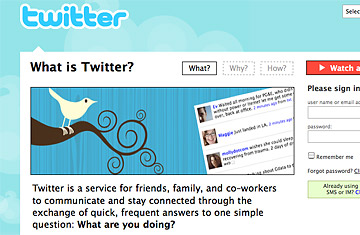
Twitter was, perhaps, inevitable. It's a Web 2.0 service that allows users to let their social network know exactly what they're doing (or feeling or thinking or eating) at every minute of every day.
If posting on a traditional long-form blog feels too ponderous and sporadic for you, Twitter may be more your speed: it limits your micro-blogposts to just 140 characters, and you can post your dispatches from your iPhone, BlackBerry or any other mobile device capable of text-messaging on-the-go.
If you haven't heard of Twitter yet — or, if you're wondering, "Why would anyone ever want to Twitter?" — you're probably, well, not young. I received quizzical looks from some friends in my age group when I mentioned it. And, invariably, after explaining what Twitter was and why it was important, I got the same response, "I just don't get it." Then I asked several of my new (18-to-24-year-old) Facebook friends why they found Twitter appealing. Their responses ranged from "It's a great way to broadcast your stream of consciousness" to "It's a more effective way of communicating with several people at once." But these answers still beg the original question: why would you ever want to Twitter in the first place?
I figured that the service would appeal exclusively to youngsters with nothing better to do. The user data, however, tell me I'm wrong, and reveal a very specific user profile: for example, males make up 63% of Twitterers, specifically males from California, whose residents account for more than 57% of Twitter's visitors. More interestingly, the age demographics of Twitterers show a dramatic shift. When the site became popular in early 2007, the majority of its visitors were 18-to-24-year-olds. Today the site's largest age demographic is 35-to-44-year-olds, who make up 25.9% of its users.
Drilling deeper into the data, you find two particularly common kinds of Twitterers. The first group, type H03 (14.7% of Twitter visitors), a.k.a the "Stable Career," comprises a "collection of young and ethnically diverse singles living in big-city metros like Los Angeles, Philadelphia and Miami." The Stable Career tends to work in the arts and entertainment industry, drive small cars and espouse very liberal political views.
The second largest type of Twitterer is H01 (12.3% of the site's visitors) — or, the "Young Cosmopolitan." These are the 40-somethings. They're likely to drive a hybrid car such as the Toyota Prius, earn household incomes over $250,000 per year and also identify with very liberal politics.
Both H03s and H01s appear to be all-around Web 2.0 fans, favoring sites like Digg, Yelp and Google Docs. They not only persistently over-share information from their own lives, but they're also passionate about finding new lives online. Specifically, Twitter visitors are often looking for a new job (they spend a lot of time on job-hunting websites) and new relationships (they like dating and matchmaking websites too). Could it be possible that chronic Twittering is a cause rather than a characteristic of our analysis?
I don't know, but I've taken the advice of my younger friends and tried streaming my own consciousness on the site. Over a 24-hour period I noticed a pattern. The thoughts going through my mind were: "What's for lunch?" and "Deciding what to have for dinner..." and "I'm hungry." Welcome to the mind of one 42-year-old California male.
Bill Tancer is general manager of research at Hitwise, and author of Click: What Millions do Online and Why it Matters.
